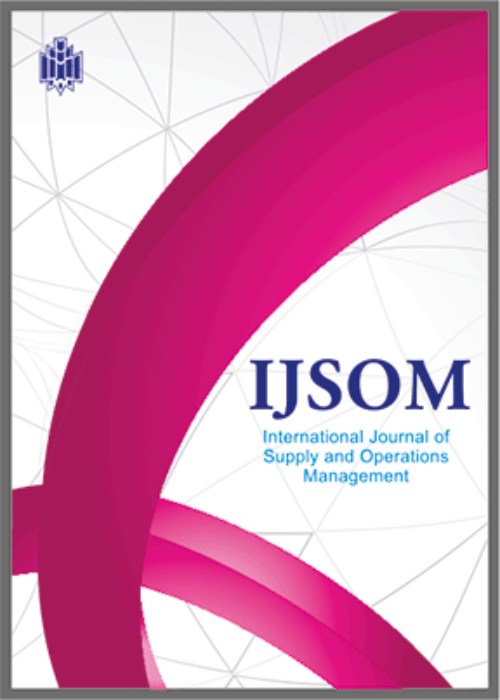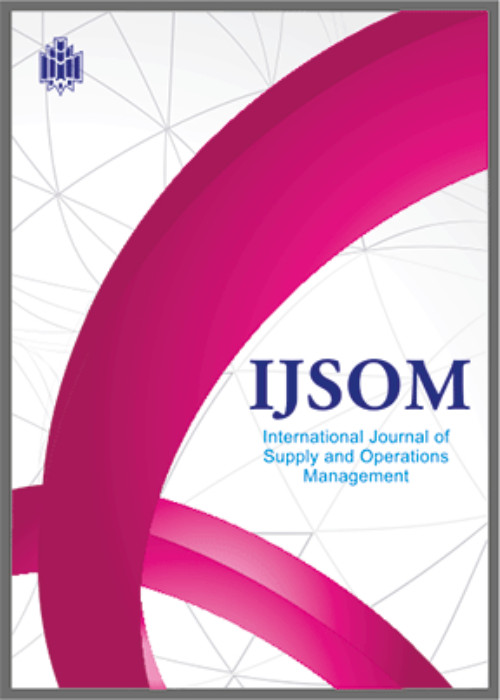فهرست مطالب

International Journal of Supply and Operations Management
Volume:10 Issue: 2, Spring 2023
- تاریخ انتشار: 1402/04/14
- تعداد عناوین: 7
-
-
Pages 117-135Today, the health care and medical sector is adopting digital technologies aggressively. However, this adoption also has significant challenges, especially during COVID-19. This research aims to identify and categorize the significant challenges related with application of Industry 4.0 (I4.0) technologies in the medical device industry. An expert-based survey is carried to capture the perception of medical device industry leaders about the challenges associated with the implementation of digital technologies. Further, interpretive structural modeling (ISM) method was used for an empirical investigation of the hierarchy and interdependencies of identified challenges. The authors have proposed a mind map and conceptual model of hierarchy and interdependencies of challenges associated with the digital transformation of the medical device industry towards I4.0. Industry leaders and policymakers worldwide are defying challenges while the digital transformation of the organizations post COVID-19. The I4.0 implementation challenges identified and ategorized in this research may aid as a guide for medical device manufacturing organizations while designing a strategy for I4.0 transformation and to make sure that they start on the right -footing. Most of the existing work is focused on the advantages of I4.0 for managing the organization's post-COVID-19, lacks thoroughness and testing. Owing to the identified gap, this study intends to empirically identify the critical challenges associated with applying I4.0 technologies in the medical device manufacturing sector. This study is a pioneer in identifying and categorizing the vital challenges needed to deal with this critical situation. A potential area of future research can be the validation of the identified challenges with a larger sample size.Keywords: Industry 4.0, Medical device manufacturing, Digital technologies COVID-19, Interpretive structural modeling (ISM), Smart factory
-
Pages 136-150The novel coronavirus has a significant impact on the whole world, especially the manufacturing sector. In this pandemic, the demand of personal protective equipment (PPE) viz., masks, face shields, gloves, hand sanitizer, etc., has increased rapidly, which has put an additional pressure on the manufacturers to increase their production to meet the escalating demand. Thus, the agile nature of demand can be addressed by incorporating volume agility in the production process. Accordingly, there is an urgent need for the manufacturers to promote their products and also to keep the public aware about the importance of various preventive measures. However, as the pandemic continues, the excess production of PPE leads to a considerable amount of carbon emissions and waste in the environment. Motivated by this, the present study develops a sustainable production model with volume agility and advertisement sensitive demand. Sustainability is addressed by incorporating carbon emission costs during the production and inventory holding. The objective is to maximize the total profit by conjointly optimizing the cycle length, advertising cost, and production rate. A numerical example is included to validate the model. Further, the sensitivity analysis unfolds valuable managerial insights for decision-makers to better management in this pandemic.Keywords: Inventory, PPE, COVID-19, Volume agility, advertisement dependent demand, Carbon emissions
-
Pages 151-173The aim of this paper was to develop a binary bi-level optimization model for the emergency warehouse location-allocation problem in terms of national and regional levels. This type of modeling is suitable for countries where the design of the disaster emergency network is decentralized. The upper-level decision-maker makes a decision regarding the location and allocation of national warehouses through considering the location of regional warehouses and allocating them to the demand cities. Each regional warehouse can provide a service for the demand cities within a specified distance threshold, ultimately affecting the efficiency of the solution algorithms. The optimization model parameters were calculated in terms of the real data in Iran. To solve the small size problem, an exact method was proposed from the explicit complete enumeration. Due to the complexity of the model with the large size, two innovative hybrid genetic algorithms, namely HG-ES-1 and HG-ES-2, were suggested. The results obtained from solving the problems showed that the HG-ES-1 algorithm outperformed HG-ES-2. The findings further indicated the proper functioning of the solution approaches.Keywords: Bi pre-positioning, Disaster management, Bi-level programming, Hybrid genetic algorithms, Location-Allocation Problem
-
Pages 174-186The scheduling of sports events has a high degree of complexity due to the large number, diversity, and the interdependence of events as well as the existence of conflicting objectives. The present study investigates the integrated scheduling of multiple types of sports events simultaneously. A variety of sports events, including competitions, management meetings, training camps, and training workshops, are scheduled simultaneously regarding the appropriateness of the timeslot for each event and the suitability of the length of the time interval between each pair of events. Previous studies were limited to detailed scheduling of single types of events. For instance, they determine when and where each team plays with other teams. However, the current paper takes a macroscopic view and sets the timeslots in which the competitions and other types of events will be held. The part of output which sets the competition timeslots can be further given as input to one of the existing algorithms which determine the detailed schedule of competitions. An integer programming formulation is developed. Numerical examples demonstrate that the general-purpose solvers cannot obtain the optimal solution of real-sized problems within an acceptable time. To solve larger problems, the fix-and-optimize matheuristic approach is employed. Numerical results show the satisfactory performance of this approach. To validate the proposed method, the sport events of the Karate Federation of Iran for a whole year are scheduled as a real case study. Finally, using the data of this case study, a sensitivity analysis is performed for some of the parameters.Keywords: Sports scheduling, Multiple sport events, Integer programming, Fix-and-optimize matheuristic, Case Study, Sensitivity Analysis
-
Pages 187-208Nowadays in markets, products are categorized as an independent, substitute, and complementary ones. Being a complementary product could impact the demand for related products, so the pricing of these items could affect the other ones’ demand. To investigate these effects, here a two-echelon supply chain with three manufacturers and a distributor for two substitutes and one complimentary product simultaneously has been investigated. The relationships between the manufacturers and the distributer are modeled by both cooperative and non-cooperative games. Due to political discussions, equipment failure, and natural disasters, our supply chain would confront disruption between the distributor and the manufacturers, which brings dissatisfaction, and the orders could not be fulfilled by manufacturers completely. Above mentioned issues bring variations in wholesalers and distributor prices. The optimal prices for both have been determined in our proposed model by taking advantage of game theories as well. Finally, the effects of key parameters on supply chain decisions and profit functions were investigated and numerical examples were developed to show the performance of the model, and sensitivity analysis was performed on important parameters to derive managerial insights.Keywords: Supply chain, Pricing, Complementary Product, Substitute Products, Game theory, Disruption Risk
-
Pages 209-222Depending on the differences in the capabilities and conditions of countries and continents, and the size of the variance when dealing with emergency crises such as the Covid-19 crisis, which has left a significant impact on logistics around the world. The study aims to identify the most prominent problems faced by countries and continents during the Covid-19 pandemic only, as well as to determine the levels of similarity and differences for these problems and methods of dealing with them in each country according to the available capabilities. This work also aims to clarify and highlight the most influential problems in various Asian, European and African countries, and to show the most appropriate solutions for each continent (Asia, Europe and Africa). In this paper, the Step-Wise Weight Assessment Ratio Analysis (SWARA) method was used, in this method experts are the main elements, and on this basis, a list was prepared that includes a set of problems and solutions got from research papers conducted during the outbreak of COVID-19, then this list was sent to a group of experts in different countries via e-mail, some of them are Asian countries, some are European, and some are African. The number of experts who responded to the questionnaire sent to them reached 22 experts, 8 from Asia, 9 from Europe, and 5 from Africa. The study found that there are great variations in the size of the problems faced by supply chains in the continents and their countries, and the solutions differ from one continent to another and from one country to another with different capabilities and adherence to the instructions for closure and cultural awareness. Therefore, understanding the problem and the solutions to it contribute a lot to addressing logistics disorders during emergency crises.Keywords: COVID-19, logistics problems, solutions, SWARA, Supply Chain Management
-
Pages 223-244In a realistic environment, operational decision problems involve several sources of uncertainty, due to measurement errors, approximate parameters, or simply the unavailability of information at the time of decision-making. These disturbances are important in the optimization process and must be taken into consideration. To meet these needs, optimization under uncertainty has emerged as an important area of modern operations research and has gained increasing popularity in recent years by tackling complex optimization problems, such as multimodal chain management and container terminals management. In this regard, the present article provides a general overview of the different optimization paradigms and approaches used in the literature to support decision-making in the face of uncertainty. In particular, this article aims to present a state of the art on application of optimization under uncertainty in multimodal transport problems, with a particular focus on the application of Robust Optimization.Keywords: Optimization, Uncertainty, Robust optimization, Multimodal transport


